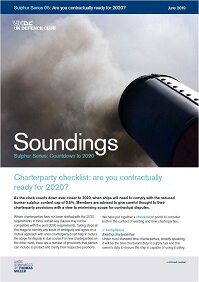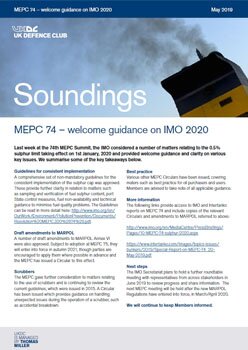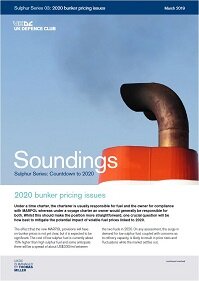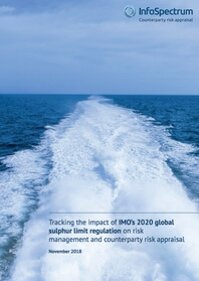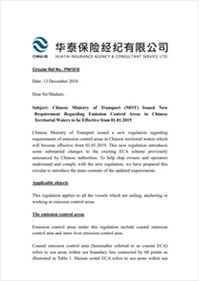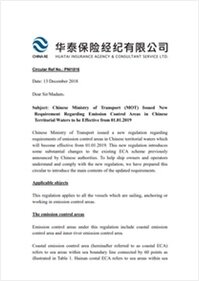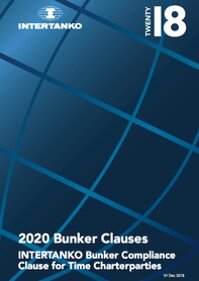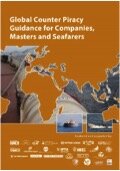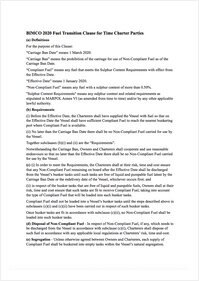IMO 2020 Sulphur Cap
As of 1st January, 2020, amendments to MARPOL brought in a global sulphur cap of 0.50%. This regulatory change, although undoubtedly a positive one for the marine environment, has nevertheless brought with it significant commercial, financial, legal and practical implications for owners and charterers alike.
In this dedicated section of our website, we offer a series of focused bulletins as well as resources and external industry guidance for the benefit of our Members.
Drafting considerations
In the lead-up to 2020, owners and charterers alike sought to implement practical and contractual measures in time for the implementation of the sulphur cap on 1st January, 2020 and the carriage ban on 1st March, 2020.
Although the transition clauses issued by BIMCO are not of on-going relevance, Members are reminded to consider the incorporation of appropriate clauses relating to sulphur content and other relevant matters when drafting new charterparties. See our commentaries on the BIMCO IMO 2020 clauses and, in the context of voyage charters, bunker pricing clauses.
Bunker quality and compliance
With fuel regularly being found to have sulphur contents only marginally above the 0.50% cap, a common and often complex debate that has arisen, and continues to arise, is whether there a margin for error.
Aside from sulphur content, many of the quality issues associated with VLSFO that were anticipated at the outset of 2020 have indeed come to the fore. In particular, we have seen a number of cases involving high sediment content (TSP), as well as low flash point, excess cat fines and presence of unidentified contaminants. There have been incidences, for example, of jet fuel (surplus during the pandemic) being used in bunkers, with potentially volatile results. Owners have also encountered issues with the incorrect use of lube oils with the new types of fuel.
Although many of the teething problems with the new fuel appear to have settled down, there continues to be a steady stream of fuel quality issues which seems likely to continue for the short term at least, given the relatively volatile and varied nature of low sulphur fuel.
For detailed guidance to dealing with fuel quality claims, please see our comprehensive Guide to Bunker Claims. The Club can also provide Members with up to date reports on bunker quality and availability.
Scrubbers
Finally, although the uptake of scrubbers as an alternative to using VLSFO has been relatively low, and may remain so in light of the narrowing price difference between VLSFO and HSFO, we remind readers of our commentary on the issues associated with scrubbers which considers some of the contractual considerations and practical pitfalls involved.
Whilst it is hoped that many of the disputes relating to the IMO sulphur cap will continue to tail off as problems with new fuels are ironed out and parties now have the appropriate contractual and technological framework in place, if issues do arise, Members are invited to contact the Club for further guidance and support.
27/06/2019
As the clock counts down ever closer to 2020, when ships will need to comply with the reduced bunker sulphur content cap of 0.5%, Members are advised to give careful thought to their
charterparty provisions with a view to minimising scope for contractual disputes.
24/05/2019
Last week at the 74th MEPC Summit, the IMO considered a number of matters relating to the 0.5% sulphur limit taking effect on 1st January, 2020 and provided welcome guidance and clarity on various key issues. We summarise some of the key takeaways in this Soundings update.
28/03/2019
Under a time charter, the charterer is usually responsible for fuel and the owner for compliance with MARPOL whereas under a voyage charter an owner would generally be responsible for both. Whilst this should make the position more straightforward, one crucial question will be how best to mitigate the potential impact of volatile fuel prices linked to 2020.
28/03/2019
The following table lists countries which have imposed bans on vessels fitted with open-loop SOx scrubbers calling at their ports, and on the discharge of washwater from these scrubber systems within their port waters.
28/03/2019
The International Energy Agency called the impending 2020 global sulphur limit “easily the most dramatic change in fuel specifcations in any oil product market on such a large scale”.
As this paper will reference, it is a truly daunting prospect for multiple stakeholders with shipowners and operators, charterers, bunker suppliers, traders, financiers, insurers, and refiners all impacted. Indeed, from a shipping perspective, the fear of the known unknowns that 2020 generates has been well-documented, yet often lacking in detail.
25/03/2019
Chinese Ministry of Transport issued a new regulation regarding requirements of emission control areas in Chinese territorial waters which will become effective from 01.01.2019. This new regulation introduces some substantial changes to the existing ECA scheme previously announced by Chinese authorities.
25/03/2019
Chinese Ministry of Transport issued a new regulation regarding requirements of emission control areas in Chinese territorial waters which will become effective from 01.01.2019. This new regulation introduces some substantial changes to the existing ECA scheme previously announced by Chinese authorities.
25/03/2019
INTERTANKO’s Documentary Committee has revised the INTERTANKO Bunker Emissions Clause, published in 2005, to take account of changes in regulation, in particular the 2020 sulphur requirements of MARPOL Annex VI; but also to deal with bunker quality and best practice in bunkering for both Owners and Charterers.
25/03/2019
BIMCO has produced two clauses for time charter parties to address key contractual issues relating to the switch to fuel with a maximum sulphur content of 0.50% as of 1 January 2020. The two clauses are the 2020 Marine Fuel Sulphur Content Clause, which replaces the BIMCO Fuel Sulphur Content Clause 2005, and the 2020 Fuel Transition Clause, which deals with switching between fuel with a maximum sulphur content of 3.50% and fuel with a maximum sulphur content of 0.50% by 1 January 2020. Both clauses should be incorporated into time charter parties.
25/03/2019
BIMCO has produced two clauses for time charter parties to address key contractual issues relating to the switch to fuel with a maximum sulphur content of 0.50% as of 1 January 2020. The two clauses are the 2020 Marine Fuel Sulphur Content Clause, which replaces the BIMCO Fuel Sulphur Content Clause 2005, and the 2020 Fuel Transition Clause, which deals with switching between fuel with a maximum sulphur content of 3.50% and fuel with a maximum sulphur content of 0.50% by 1 January 2020. Both clauses should be incorporated into time charter parties.
